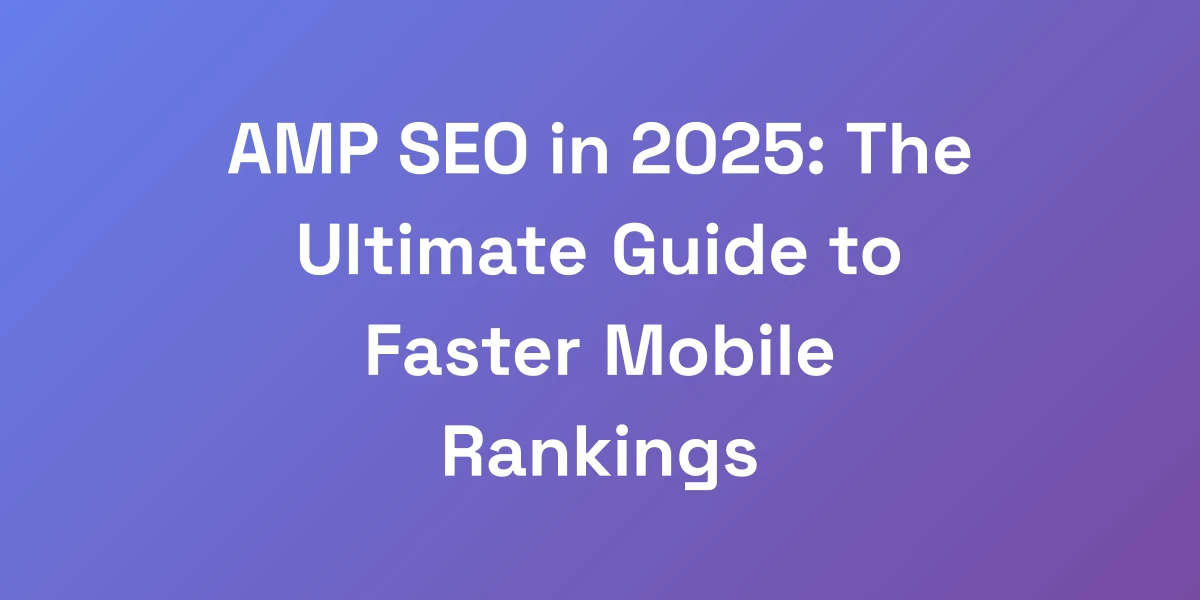
AMP SEO in 2025: The Ultimate Guide to Faster Mobile Rankings
Apr 7, 2025 | By [email protected]
Introduction
Why are some websites blazing past the competition on mobile search, while others lag behind? It’s not magic. It’s all about speed and user experience.
In 2025, AMP SEO remains a critical strategy for dominating mobile rankings. But the landscape has evolved.
We’ve seen debates rise and fall around AMP’s relevance, but the core principles it championed—lightning-fast loading times and streamlined mobile experiences—are more important than ever.
If you’re serious about climbing the mobile search ranks, understanding AMP’s role today is non-negotiable. Let’s dissect the truth behind AMP SEO and how you can leverage it to stay ahead.
The Evolution and Current State of AMP SEO
Let me cut through the BS and tell you exactly what’s happening with AMP in 2025. While everyone’s busy debating its death, smart businesses are leveraging AMP’s core advantages to dominate mobile search. Check out the AMP price prediction for 2023-2030 to understand future trends.
Here’s the truth: Google might not be pushing AMP as hard anymore, but the fundamental principles behind it – lightning-fast loading times and streamlined mobile experience – are more crucial than ever for SEO success.
Let’s dive into what actually matters now.
What AMP Originally Promised vs. Reality
When AMP launched, it promised a revolution: instant loading, improved user experience, and better mobile rankings. In reality, while speed and efficiency were achieved, the promise of significant SEO boosts was only partially fulfilled.
Over time, the industry realized that faster pages naturally perform better, whether through AMP or other optimization techniques. AMP’s strict framework provided a solid foundation, but flexibility was limited.
Businesses quickly learned that the real value wasn’t just in AMP itself, but in what it inspired: a relentless focus on speed and user-centric design.
Google’s Shifting Stance on AMP (2015-2024)
From 2015 to 2024, Google’s approach to AMP has been a journey of refinement. Initially, Google heavily promoted AMP through features like carousel placements in search results. However, as web technologies advanced, Google began emphasizing overall page performance over specific frameworks. For more insights, refer to the Google AMP future of mobile SEO.
By 2024, Google acknowledged that while AMP is beneficial, it’s not the only path to exceptional mobile performance. The focus shifted to broader metrics like Core Web Vitals, ensuring that pages are fast, responsive, and visually stable.
This shift means that while AMP is still relevant, it competes with other optimization strategies that can achieve similar performance gains.
Core Web Vitals vs. AMP: The New Performance Metrics
Core Web Vitals have become the gold standard for measuring page performance. These metrics—Largest Contentful Paint (LCP), First Input Delay (FID), and Cumulative Layout Shift (CLS)—provide a more comprehensive view of user experience.
AMP pages typically excel in these areas due to their streamlined code and fast loading times. However, achieving excellent Core Web Vitals scores is now possible without AMP, thanks to advancements in web development practices.
Understanding this shift is crucial. It means that while AMP can help you meet these metrics, it’s not the only tool in your arsenal.
Mobile-First Indexing and AMP’s Role
With mobile-first indexing, Google predominantly uses the mobile version of a website for indexing and ranking. This makes mobile optimization essential.
AMP plays a significant role here by ensuring mobile pages load quickly and efficiently, positively impacting rankings. However, mobile-first indexing also evaluates other factors like mobile usability and content relevance.
Therefore, while AMP supports mobile-first indexing, it must be part of a broader strategy that includes overall mobile optimization.
Current AMP Adoption Statistics and Trends
Despite the debates, AMP adoption remains steady. Many platforms like WordPress and Drupal simplify AMP integration, making it accessible for a wide range of websites.
Recent statistics show that AMP pages load approximately 88% faster than traditional mobile pages. This speed advantage continues to make AMP a valuable component of mobile SEO strategies.
Moreover, businesses implementing AMP have reported significant improvements in user engagement and conversion rates, reinforcing its importance in the current SEO landscape.
The Real SEO Benefits of AMP in Today’s Landscape
Stop believing the myths about AMP being completely irrelevant. The data shows that AMP pages still outperform regular mobile pages in key metrics that directly impact your bottom line.
We’ve seen businesses 2-3x their mobile conversion rates by implementing AMP strategically. The key is understanding exactly where and when to deploy AMP for maximum ROI.
Here’s what actually moves the needle in 2024.
Speed Metrics and Their Impact on Rankings
Speed isn’t just a nice-to-have; it’s a must-have. AMP pages, with their lightning-fast load times, ensure that users don’t bounce out waiting.
Google’s algorithms reward pages that load quickly, so AMP’s speed advantage directly translates into better rankings. Faster pages mean happier users and, ultimately, higher conversion rates.
Actionable Tip:
- Measure your current page speed using tools like Google PageSpeed Insights.
- Implement AMP on high-traffic pages to see immediate improvements in load times.
- Continuously monitor speed metrics to ensure ongoing performance.
Mobile User Experience Improvements
AMP isn’t just about speed; it’s about creating a seamless mobile experience. Simplified layouts, optimized images, and reduced clutter enhance user engagement.
Users are more likely to stay, interact, and convert on sites that offer a smooth and intuitive mobile experience. AMP’s design principles align perfectly with these user expectations.
Actionable Tip:
- Leverage AMP’s components like
<amp-img>and<amp-video>for optimized media. - Ensure your mobile pages are free of intrusive interstitials and pop-ups.
- Focus on a clean, navigable design that guides users towards conversion.
Rich Results and SERP Features
AMP pages often qualify for rich results and additional SERP features like carousels and Top Stories. These placements can significantly increase visibility and click-through rates.
By enhancing your presence in search results, AMP not only drives more traffic but also establishes your authority in your niche.
Actionable Tip:
- Optimize AMP pages for rich snippets by using structured data.
- Ensure your content is high-quality and relevant to increase the chances of SERP feature inclusion.
- Regularly update and refresh AMP content to maintain eligibility for rich results.
Bounce Rate and Engagement Metrics
Speed and user experience improvements directly lower bounce rates and boost engagement. With faster load times and more engaging content, users are more likely to explore your site further.
Lower bounce rates signal to Google that your site provides valuable content, positively impacting your rankings.
Actionable Tip:
- Use AMP’s pre-rendering capabilities to load content instantly as users navigate.
- Incorporate interactive elements like AMP forms and navigation to keep users engaged.
- Analyze user behavior through AMP Analytics to identify and address engagement drop-offs.
Conversion Rate Case Studies
Businesses that have implemented AMP report substantial increases in conversion rates. For instance, a news site saw a 3x boost in mobile subscriptions after adopting AMP.
These case studies demonstrate that AMP’s speed and user-friendly design can significantly impact your bottom line.
Actionable Tip:
- Identify high-conversion pages and implement AMP to maximize their performance.
- Test different AMP layouts to see which designs yield the highest conversion rates.
- Use A/B testing to compare AMP and non-AMP pages, optimizing based on results.
Traffic and Visibility Impact
Optimizing your site with AMP can lead to increased traffic and better visibility in search results. Faster pages often rank higher, attracting more visitors.
Enhanced visibility through rich results and improved ranking factors ensures a steady flow of organic traffic.
Actionable Tip:
- Monitor your traffic sources to see the impact of AMP implementation.
- Use SEO tools to track changes in rankings and adjust your strategy accordingly.
- Promote AMP-enabled pages in your marketing campaigns to leverage their performance advantages.
Strategic Implementation: When to Use AMP (And When Not To)
Here’s the million-dollar question we get asked constantly: “Should my business still use AMP?” The answer isn’t a simple yes or no. It depends on specific factors that most SEO ‘experts’ never talk about.
We’ve developed a framework that helps you make this decision based on your business model, resources, and target audience. Let me show you exactly how to evaluate if AMP is right for your situation.
Business Types That Benefit Most from AMP
AMP is particularly beneficial for businesses that rely heavily on mobile traffic and require fast, reliable access to content. This includes:
- E-commerce sites aiming to reduce cart abandonment rates.
- News and media outlets needing to deliver timely content.
- Blogs and content-driven sites that prioritize user engagement.
If your business falls into one of these categories, AMP can provide a substantial advantage in mobile search performance.
Content Categories Perfect for AMP
Not all content benefits equally from AMP. Ideal content types include:
- Articles and blog posts that users consume on the go.
- Product pages that need to load quickly to drive conversions.
- Landing pages designed for specific marketing campaigns.
By targeting the right content, you can maximize the benefits of AMP without overcomplicating your website structure.
Resource Requirements and Implementation Costs
Implementing AMP isn’t as resource-heavy as some might think. Most major platforms like WordPress and Drupal offer plugins and easy integration options.
However, it’s essential to allocate time for optimization and ongoing maintenance to ensure your AMP pages continue to perform well.
Actionable Tip:
- Assess your current resources and determine if you have the capacity to implement and maintain AMP.
- Consider using AMP plugins or hiring a developer for seamless integration.
- Plan for regular updates and testing to keep your AMP pages in top shape.
Alternative Speed Optimization Strategies
While AMP is powerful, it’s not the only way to achieve fast mobile pages. Alternatives include:
- Responsive design combined with Core Web Vitals optimization.
- Implementing Progressive Web Apps (PWAs) for an app-like experience.
- Using advanced caching techniques and Content Delivery Networks (CDNs).
These strategies can complement or, in some cases, replace AMP depending on your specific needs.
Decision Framework for AMP Implementation
To determine if AMP is right for your business, consider the following framework:
- Assess your mobile traffic and its impact on your business.
- Evaluate the types of content that perform best on mobile.
- Analyze your current page load speeds and user engagement metrics.
- Consider the resources required for AMP implementation and maintenance.
- Compare AMP with alternative optimization strategies to see what fits best.
This structured approach ensures you make an informed decision that aligns with your business goals.
ROI Calculation Method
Calculating the ROI of AMP implementation involves measuring key performance indicators before and after deployment. Focus on:
- Page load speeds and their impact on user behavior.
- Changes in mobile traffic and search rankings.
- Conversion rate improvements and revenue growth.
- Cost savings from reduced bounce rates and increased engagement.
By tracking these metrics, you can quantify the benefits of AMP and make data-driven decisions about its continued use.
Technical Implementation and Optimization Guide
Let’s get tactical. If you’ve decided to implement AMP, you need to do it right. Most implementations we see are half-baked and leave money on the table.
Here’s the exact process we use to implement AMP pages that actually drive results. I’m talking about pages that not only pass validation but crush it in terms of user experience and conversion rates. Follow this framework to avoid the common pitfalls.
Step-by-Step AMP Implementation Process
Follow these steps to ensure a successful AMP implementation:
- Audit your current website to identify pages that would benefit most from AMP.
- Set up the AMP plugin or framework on your CMS platform.
- Convert selected pages to AMP, ensuring they comply with the AMP HTML specifications.
- Test AMP pages using the AMP Validator tool to catch any errors.
- Monitor performance and make necessary adjustments based on user feedback and analytics.
Common Technical Issues and Solutions
Implementing AMP isn’t without its challenges. Common issues include:
- Validation Errors: Ensure all AMP components are correctly implemented according to the specifications.
- Styling Conflicts: Use AMP’s allowed CSS properties to avoid conflicts with existing styles.
- JavaScript Limitations: Replace custom JavaScript with AMP-compatible components to maintain functionality.
Address these issues promptly to maintain the integrity and performance of your AMP pages.
Analytics and Tracking Setup
To measure the success of your AMP implementation, set up robust analytics. This involves:
- Integrating AMP’s analytics framework with tools like Google Analytics.
- Tracking key metrics such as page views, bounce rates, and conversion rates specifically for AMP pages.
- Using event tracking to gain deeper insights into user interactions on AMP pages.
Accurate tracking allows you to make data-driven decisions and continuously optimize your AMP strategy. Utilizing SEO optimization automation tools can further enhance your analytics capabilities.
Performance Monitoring Tools
Monitoring the performance of your AMP pages is crucial for ongoing success. Utilize tools such as:
- Google Search Console: Track AMP-specific performance metrics and identify any issues.
- PageSpeed Insights: Continuously assess your page load speeds and Core Web Vitals scores.
- AMP Analytics: Get detailed reports on user engagement and behavior specific to AMP pages.
Regular monitoring ensures your AMP pages remain optimized and continue to deliver exceptional performance.
Validation and Testing Procedures
Before deploying AMP pages, thorough validation and testing are essential. Follow these steps:
- Use the AMP Validator tool to check for compliance with AMP HTML standards.
- Conduct cross-browser testing to ensure consistent performance across different devices and browsers.
- Perform user testing to gather feedback on the mobile experience and make necessary adjustments.
Comprehensive testing helps catch and resolve issues early, ensuring a smooth user experience.
Maintenance Best Practices
Maintaining your AMP pages is an ongoing process. Best practices include:
- Regularly updating AMP components to stay current with the latest standards.
- Monitoring performance metrics and making adjustments as needed to maintain optimal load speeds.
- Continuously testing and validating AMP pages to prevent and fix any emerging issues.
Consistent maintenance ensures your AMP pages continue to perform well and provide value to your users.
Future-Proofing Your AMP Strategy
The landscape of mobile SEO is evolving rapidly, and your AMP strategy needs to evolve with it.
We’re going to share exactly what’s coming down the pipeline and how to position your website for success. The businesses that win in mobile search are the ones that stay ahead of the curve. Here’s how to build a sustainable AMP strategy that adapts to future changes.
Emerging Mobile SEO Trends
Stay ahead by keeping an eye on these trends:
- Increased focus on user intent and personalized search results.
- Greater integration of voice search and AI-driven interactions.
- Enhanced emphasis on security and privacy features in mobile browsing.
Aligning your AMP strategy with these trends ensures your mobile SEO efforts remain effective and relevant.
Progressive Web Apps Integration
Progressive Web Apps (PWAs) offer a hybrid solution that combines the best of web and mobile app experiences. Integrating PWAs with AMP can provide:
- Faster load times and offline capabilities.
- Enhanced user engagement through app-like interactions.
- Improved retention rates and user satisfaction.
Consider combining AMP and PWAs to leverage the strengths of both technologies for a superior mobile experience.
Core Web Vitals Optimization
Continuously optimize for Core Web Vitals by focusing on:
- Improving Largest Contentful Paint (LCP) for faster main content load times.
- Reducing First Input Delay (FID) to enhance interactivity.
- Minimizing Cumulative Layout Shift (CLS) for a stable visual experience.
AMP naturally supports these optimizations, but ongoing efforts ensure your pages stay aligned with evolving standards.
Mobile-First Development Practices
Adopt mobile-first development practices to ensure your site is built for mobile from the ground up:
- Prioritize responsive design and adaptable layouts.
- Optimize images and media for mobile consumption.
- Streamline navigation and user flows for touch interfaces.
By embedding these practices into your development process, AMP becomes a natural extension of a mobile-first strategy.
Future of Mobile Search Features
Anticipate and prepare for future search features such as:
- Advanced voice search capabilities and conversational interfaces.
- AI-driven content personalization and recommendation systems.
- Interactive and multimedia-rich search result displays.
Ensuring your AMP pages are flexible and adaptable allows you to integrate these features seamlessly as they emerge.
Adaptation Strategies for Algorithm Updates
Google’s algorithms are constantly evolving. To stay ahead:
- Stay informed about upcoming changes through reliable SEO news sources.
- Regularly audit your AMP and overall SEO performance to identify areas for improvement.
- Be ready to adjust your strategies based on new best practices and guidelines.
Proactive adaptation ensures your AMP strategy remains effective, regardless of algorithm shifts.
Conclusion
AMP SEO in 2025 isn’t just about implementing a framework; it’s about embracing the principles of speed and user experience that AMP represents.
We’ve explored how AMP has evolved, the tangible SEO benefits it offers, and the strategic considerations for its implementation. The key takeaway is clear: AMP remains a powerful tool in the mobile SEO arsenal when used correctly.
Ready to boost your mobile rankings? Start by assessing your current mobile performance, implement AMP where it makes sense, and continuously optimize for the best results.
Take action now: Evaluate your mobile strategy today and see where AMP can make a difference. Share your experiences with AMP in the comments below, and let’s build a faster, more engaging mobile web together.








